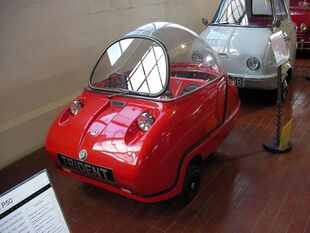Engineering:Peel Trident
| Peel Trident | |
|---|---|
 | |
| Overview | |
| Manufacturer | Peel Engineering Company (1965–66) Peel Engineering Ltd. (2011–present) |
| Production | 1965–66 Approximately 45[1] produced 2011–present |
| Designer | Cyril Cannell |
| Body and chassis | |
| Class | Microcar |
| Body style | Flip-top (no-door) coupé |
| Layout | Rear-engine, rear-wheel drive |
| Related | Peel P50, Peel Manxcar, Peel Viking Sport |
| Powertrain | |
| Engine | DKW 49 cc, 4.2 hp although some cars: Triumph Tina 99 cc |
| Transmission | 3-speed manual |
| Dimensions | |
| Length | 190 cm (73 in)[1] |
| Width | 99 cm (39 in)[1] |
| uk|uk|Kerb|Curb}} weight | 150 kg (330 lb)[1] |
| Chronology | |
| Predecessor | Peel P50 |
| Successor | Peel Viking Sport |

The Peel Trident is the second three-wheeled microcar built by the Peel Engineering Company on the Isle of Man. An all-new design from its one-seat counterpart the Peel P50, the Trident has two seats.
History
The Trident was launched at the 1964 British Motorcycle Show held at Earls Court. The seat, stated as being 31 in (79 cm) wide, was intended to provide for use as an occasional two-seater.[2]
A completely new design from the earlier side-engined Peel P50 microcar, the Trident was manufactured in 1965 and 1966.
In 2011, Peel Engineering Ltd. reinstated manufacture of the Peel Trident and P50, in Sutton-in-Ashfield, near Nottingham, England. All vehicles are hand-built to order in petrol and electric form.[3]
Description and specifications
The glass-fibre shell was a monocoque with coil-sprung, undamped wheels.[2] It featured a clear bubble top[4] and either two seats or one seat with a detachable shopping basket.
The Lakeland Motor Museum observes that the Trident's bubble top constituted grounds for its sobriquet "The Terrestrial Flying Saucer."[5] Like its predecessor, it was marketed as a "shopping car" or a "Saloon Scooter".[citation needed]
The car is 73 in (185 cm) long and 39 in (99 cm) wide, with a weight of 330 lb (150 kg).[1] Like the P50, it uses a 49 cc (3.0 cu in) DKW engine which generates 4.2 hp (3.1 kW), and a top speed of 28 mph (45 km/h). It was advertised that the Trident got 100 miles per imperial gallon (2.8 L/100 km; 83 mpg‑US), "almost cheaper than walking". The original retail price was £190.[1]
All engines supplied to Peel from Zweirad Union (for both the P50 and Trident) were of the 49 cc 3-speed 4.2 hp 804–1600 type. Uniquely, however, the Peel engines had the 8th digit as a 4, thus being of the form 80416004***.[citation needed] This car is one of the smallest in the world.[5]
Media appearances
The Trident made a late transatlantic media appearance in the American television series Monster Garage, when a team of engineers and fabricators attempted to fit a high-performance Suzuki Hayabusa superbike engine into the bodywork of a Trident, mounted onto a conventional go-kart frame. The project was a failure, and the unfinished car was destroyed by the show's host Jesse James with a single shot from a .50 caliber sniper rifle.[6]
It also made a brief appearance in the BBC motoring programme Top Gear on BBC Two, when the P50 was featured more extensively and the Trident was introduced as a "sports version". Co-presenter James May described the Peel Trident as "something out of The Jetsons", and co-presenter Jeremy Clarkson described the Trident and the P50 as his perfect two-car garage.
The Trident appeared on the BBC business programme Dragons Den in August 2010. The Trident made another appearance, driven by Rutledge Wood, on the second episode of the third season of Top Gear US.
The vehicle is included in Time (magazine) 's list of the 50 Worst Cars Ever.[4]
The Trident appears in the racing video game Forza Horizon 4 and Forza Horizon 5.
References
- ↑ 1.0 1.1 1.2 1.3 1.4 1.5 "1965 Peel Trident". Lane Motor Museum. http://www.lanemotormuseum.org/collection/cars/item/peel-trident-1965.
- ↑ 2.0 2.1 "Earls Court Parade". The Motor Cycle: 858–859. 10 November 1964.
- ↑ "p50cars.com – Remanufacturing the World's Smallest Car!". https://p50cars.com/.
- ↑ 4.0 4.1 Neil, Dan (2007). "50 Worst Cars Ever". Time (magazine). http://www.time.com/time/specials/2007/article/0,28804,1658545_1658498_1657834,00.html.
- ↑ 5.0 5.1 "Meet the World's smallest motor cars". Lakeland Motor Museum. Archived from the original on 1 November 2013. https://web.archive.org/web/20131101013736/http://www.lakelandmotormuseum.co.uk/news-small.php. Retrieved 30 October 2013. "The Peel Trident has its own claim to fame as being accredited as the World's smallest two seat motor car."
- ↑ "Monster Garage Season 3 Episode 58". Archived from the original on 6 October 2006. https://web.archive.org/web/20061006131922/http://dsc.discovery.com/fansites/monstergarage/episode/season3/episode_58.html.
External links
- Information, photos and factory movie at MicroCarMuseum.com
- Peel Cars, includes photographs at their hometown in Isle of Man
- Multi-make Microcar Club
- Manufacturer of reproduction Tridents P50CARS.com
- Peel Microcars, Isle of Man.
- Peel Owner's Club Peel Owner's Club - Website for owners of original Peel Tridents and faithful replicas, a source for history, image gallery and spare parts.
 |
